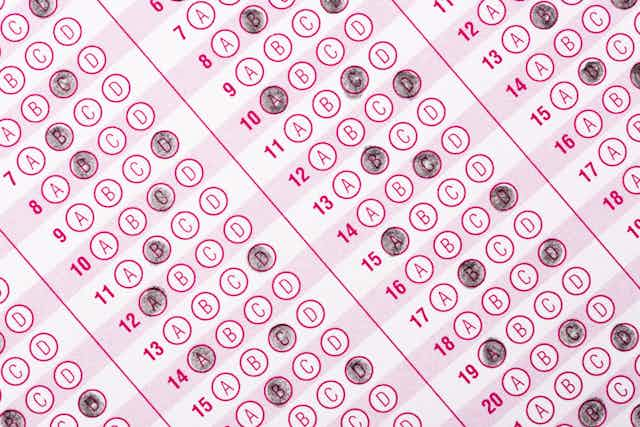Were you born with a timeclock in your mind?
If your immediate response to that question – from the 1964 edition of the Gray-Wheelwright Jungian Type Survey – is general bemusement, then the multiple choice answers that follow are unlikely to help you. The two options are simply “no” or “yes”.
How about “Is the telephone bell a pleasure?”. Or “Do you like pictures with a sense of (a) soaring upward? or (b) closeness to earth?” (both taken from the same survey). Still baffled? Then you might have had some trouble with historical personality tests.

These kinds of “psychometric instruments” – to use the technical term – emerged in the early 20th century as a way to measure “intelligence”. First used to assist French schoolchildren, the Binet-Simon scale, for example, was taken up in the US by a Stanford psychologist who published it in 1916 as the Stanford-Binet test, which gave a score, the intelligence quotient, or IQ.
This marked the beginning of an attempt to simplify and standardise broad complicated ideas: preferably into numbers. World War I provided fertile ground for psychological approaches in general to prove their worth, from the treatment of shell shock to the screening of recruits for leadership qualities.
During the interwar period, psychology gained some acceptance within the elite educated classes but this was mostly in the psychoanalytic vein: wordy, detailed and personalised. Leonard and Virginia Woolf published early English translations of Freud from their basement in Bloomsbury and there were also popular editions, such as Barbara Low’s Brief Account of Freudian Theory (1920) and Violet Firth’s Machinery of the Mind (1922).
Tick-box personalities
But some psychologists eschewed the idea that the human mind is simply a Freudian mess of fantasy, castration and incest, only accessible through lengthy and expensive analysis. Instead, they reasoned that the mind must have a number of measurable characteristics that might be compared with others. They sought to do this on a much larger scale than could be achieved through the time-intensive therapy of psychoanalysis. And so questionnaires with multiple choice answers came into their own. Psychologists such as Gray and Wheelwright, or the mother-and-daughter team of Katherine Briggs and Isobel Myers, set about trying to turn Jungian analysis of “types” into a set of multiple choice questions.

This was part of the attempt to establish psychology as a science, a move towards an ideal of objectivity. Psychological laboratories had been kitted out for some time with instruments to measure precise reaction times and to dispense precise stimuli, as a means of taking the personal and subjective out of psychological assessment. And the fact that such experiments – and these new personality tests – produced numbers meant that they could take advantage of novel and prestigious computing labs at university campuses in the postwar world.
So began the trend of reducing personality to a limited number of variables. Gray and Wheelwright, for example, worked on a model of three scales, with opposing qualities at either end. “Introversion-extroversion” marks the “general attitude” of a person. There are then two secondary characteristics, either “intuition” or “sensation”, which characterises how a person perceives the world; and “thinking” or “feeling”, which describes how one appraises one’s perceptions.
Tasteful hotel lobbies
Tests of this type can be criticised on a number of levels – that in the desire to produce numbers for computation and comparison, they lose the mental phenomena they are trying to capture. Others might say that these tests do not judge what people are like, but only what they think they are like – the pub bore who thinks they’re a brilliant listener, for example. Modern versions of these kinds of tests are everywhere. Businesses still give managers a modernised Myers-Briggs test to identify “performance enhancement opportunities” on team-building away days. There’s also the tantalising promise of “knowing your true personality” after just a few clicks online.
But what I find particularly fascinating about all tests of this kind is how culturally embedded they are. One test, for example, asks: “Do you like to chat with clerks, hairdressers, porters, etc.?” This is a test of introversion-extroversion but it rather presumes that the people taking the test will not be the ones serving, carrying bags or cutting hair. Similarly, there’s the obscure question “Suppose you were waiting in a hotel with two lobbies, each in good taste in different colours, which would you choose to wait in? (a) Blues (b) Reds”. It’s evidently important that both lobbies are “tasteful”.

Class politics come through in such questions about chatting with porters, or choosing between hotel lobbies decked out in equally good taste. And consider questions about relationships or stereotypes: in different times and places, people will be comfortable reporting different things, even if they’re totally anonymous.
There is a deeper point here, too. What we are able to feel, and the ways in which we make sense of our emotional life, change over time. From passions and humours, to ego drives and death instincts, to hormones and neurochemicals, what we “know” about how we feel changes they way we actually feel, not just how we report it. How these tests mark out the parameters of our personality is eloquent testimony to how historically determined our emotions really are.
Chris Millard will be presenting some of these historical psychometric tests at the Wellcome Collection’s Friday Late Spectacular: Feeling Emotional on February 5.

